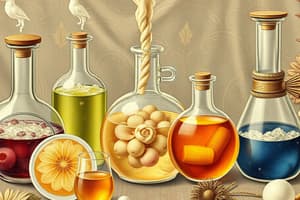Podcast
Questions and Answers
What is the study of chemistry primarily concerned with?
What is the study of chemistry primarily concerned with?
- Exploring the formation of molecules in space
- Understanding the behavior of subatomic particles
- Investigating the properties of different states of matter
- Studying elements and their chemical composition, structure, and reactions (correct)
What is matter defined as?
What is matter defined as?
- Anything that has a physical form
- Anything that has mass and occupies volume
- Anything that is composed of atoms
- Anything that takes up space and can be weighed (correct)
What is the basic unit of matter?
What is the basic unit of matter?
- Atom (correct)
- Proton
- Molecule
- Electron
What are the two main categories into which matter can be categorized?
What are the two main categories into which matter can be categorized?
What is a molecule?
What is a molecule?
What is an atom composed of?
What is an atom composed of?
What determines the chemical properties of an atom?
What determines the chemical properties of an atom?
What are the states in which matter can exist?
What are the states in which matter can exist?
What are molecules held together by?
What are molecules held together by?
What is plasma?
What is plasma?
What is a pure substance?
What is a pure substance?
What are atoms the defining structure of?
What are atoms the defining structure of?
What is an element?
What is an element?
What does the atomic number of an element represent?
What does the atomic number of an element represent?
How is density defined?
How is density defined?
If you cut a metal rod with a density of 3.5 g/mL in half, what is the density of each half?
If you cut a metal rod with a density of 3.5 g/mL in half, what is the density of each half?
Why can objects that are the same size have different masses?
Why can objects that are the same size have different masses?
Do two objects with the same mass always have the same volume?
Do two objects with the same mass always have the same volume?
What is the correct sequence of steps in the scientific method?
What is the correct sequence of steps in the scientific method?
When an object is submerged in water, what happens to the water level?
When an object is submerged in water, what happens to the water level?
What does a graduated cylinder measure?
What does a graduated cylinder measure?
Where did the metric system originate?
Where did the metric system originate?
Which of the following is a qualitative observation?
Which of the following is a qualitative observation?
Why is the metric system used in science?
Why is the metric system used in science?
Flashcards are hidden until you start studying




